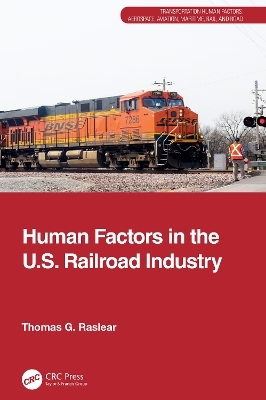
Human Factors in the U.S. Railroad Industry
CRC Press (Verlag)
978-1-032-77140-3 (ISBN)
- Noch nicht erschienen (ca. März 2025)
- Versandkostenfrei
- Auch auf Rechnung
- Artikel merken
At the heart of United States Railroad Industry are human operators who continue to make it work and operate. However, humans are susceptible to error, fatigue and risky behaviors and understanding how they impact the safety of the industry continues to be studied. Human Factors in the U.S. Railroad Industry investigates the human factor behind one of the world’s biggest railway networks and synthesizes the body of research that has been produced by the Federal Railroad Administration (FRA) on Human Factors in the Railroad industry since 1993.
During that time over 120 FRA reports were published on topics such as accident analysis, grade crossing safety and trespassing, working conditions and ergonomics, employee fatigue, safety culture, and track inspection. This title organizes this body of work into topic areas that correspond to Moray’s Sociotechnical System (2006) to provide a comprehensive way to understand the relationship between policy, organizational culture, and system safety. It discusses tools such as risk exposure, signal detection theory and program evaluation that have been applied to railroad projects and can be used to improve future railroad and transportation research. It provides a synthesis of the reports across topic areas such as fatigue, ergonomics and safety culture that are currently important within the wider human factors transportation research community. The reader will develop an understanding of a “human-centered systems” approach to the railroad industry, which focuses on human capabilities and limitations with respect to human/system interfaces, operations, system integration, and organizational influences on safety.
This book will appeal to researchers, academics, students and professionals interested in human factors, railway engineering, civil engineering and industrial engineering.
Thomas G. Raslear is an Independent Human Factors Consultant based in Maryland, USA. He has over 40 years of experience in experimental psychology and human factors research. For 23 years, he was based at the Federal Railroad Administration (FRA) until his retirement. At FRA, he was Chief of the Human Factors Research Division in the Office of Research and Development. He is an internationally known expert in fatigue in the railroad industry and has published extensively on the effects of work schedules on fatigue and accidents. Tom was a member and former chair of the U.S. Department of Transportation Human Factors Coordinating Committee and a member of the Transportation Research Board Standing Committee on Railroad Operational Safety (AR070). He is also an internationally known expert on grade crossing human factors and accident causation and has published extensively on the use of Signal Detection Theory in the analysis of motorist behavior at grade crossings.
Contents
Foreword
Acknowledgements
About The Author
Preface
Section I. Introduction, Overview and Context
Chapter 1. Introduction and Overview
Chapter 2. Social, Legal and Policy Context
Section II. Analytic Methods
Chapter 3. Data Issues
Chapter 4. Exposure
Chapter 5. Signal Detection Theory
Section III. Grade Crossings and Trespassing
Chapter 6. Grade Crossing Safety and Trespassing
Section IV. Railroad Systems and Operations
Chapter 7. Fatigue and Hours of Service Regulations
Chapter 8. Working Conditions and Ergonomics
Chapter 9. Safety Culture Programs
Chapter 10. Track Inspection
Index
| Erscheint lt. Verlag | 20.3.2025 |
|---|---|
| Reihe/Serie | Transportation Human Factors |
| Zusatzinfo | 28 Tables, black and white; 83 Line drawings, black and white; 1 Halftones, black and white; 84 Illustrations, black and white |
| Verlagsort | London |
| Sprache | englisch |
| Maße | 156 x 234 mm |
| Themenwelt | Technik ► Fahrzeugbau / Schiffbau |
| ISBN-10 | 1-032-77140-2 / 1032771402 |
| ISBN-13 | 978-1-032-77140-3 / 9781032771403 |
| Zustand | Neuware |
| Haben Sie eine Frage zum Produkt? |
aus dem Bereich


